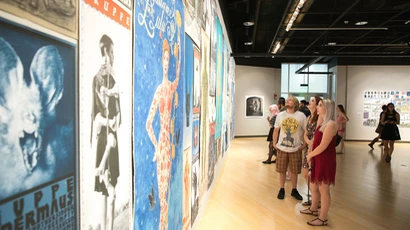
Arts Administration Internships Details
 Internships, apprenticeships, and learning-by-doing is a time-honored tradition in the field of arts administration. Academic programs in our field historically offered such programs before they became popular with other disciplines. This is partly because of the nature of the work involved, but it is also due to the fact that most arts organizations in our country have never been well funded, and frankly, interns have always provided a source of inexpensive (usually or nearly-free) labor.
Internships, apprenticeships, and learning-by-doing is a time-honored tradition in the field of arts administration. Academic programs in our field historically offered such programs before they became popular with other disciplines. This is partly because of the nature of the work involved, but it is also due to the fact that most arts organizations in our country have never been well funded, and frankly, interns have always provided a source of inexpensive (usually or nearly-free) labor.
You should think of your internship as a job. If you are lucky, you might locate an off-campus internship that pays a salary or provides a stipend (or at least provides room and board), but the main reason you are there is not monetary compensation, but to learn all you can. Therefore, you should approach your search for your internship just as you would a search for a job -- research multiple possibilities, do research on the company or companies you want to internship for, be professional when you contact the organization, have an updated resume ready, and find out how you can be of help to them.
About Learning Contracts
It is best if learning contracts can be completed and signed by all parties (you, Mr. Westwood, your agency field supervisor and the head of the CDO) before you start your internship. Sometimes, this is not possible. When this is the case it is mandatory that the contract be completed by the end of the second week of the semester.
When you go to fill out your learning contract, (forms available at the Career Development Web site) there are three main sections: Educational Objectives, Job Requirements, and Method of Evaluation. We recommend starting with the Job Requirements first -- find out what the "employer" needs done, and what their specific needs and expectations are. If the organization has had interns in the same or similar position before, they will have a pretty good idea. If internships are a new concept for the organization, they may need more help. The important thing is that you and the agency supervisor (your "boss" at the internship) have a clear mutual understanding of what it is exactly you are expected to do.
After you and your agency supervisor have agreed on the job requirements, it is relatively easy to work backwards to Educational Objectives. Basically, you want to learn about the operation of the the kind of organization(s) or department(s) you are working for. You may also want to develop your skills (such as writing, graphic design, and web site maintenance) better.
For Methods of Evaluation, we have found that the five following elements work well for most internships:
- Weekly Journal e-mailed to faculty sponsor (length and amount of detail will vary by credit hours)
- Mid-Semester and End-of-Semester evaluation by agency supervisor (the CDO will automatically send a form)
- Mid-Semester and End-of-Semester self-evaluation by student (the CDO will automatically send a form)
- Any work samples generated (for instance, if you are writing press releases, please submit copies)
- End-of-Semester paper reflecting on what you learned (length will vary by credit hours)
Notes on the top section of your form:
- All arts administration internships are graded on a S/U (Satisfactory/Unsatisfactory) basis.
- Do not expect to be paid for an on-campus internship. It is possible however to be paid for an off-campus internship. This is totally up to the sponsoring off-campus agency.
- You need to do 40 clock hours of experiential learning for each credit received. Therefore, an off campus summer internship that lasts for 15 weeks and has an obligation of 40 hours per week, entitles you to 15 credit hours. An internship during a regular 15-week semester that involves only nine hours per week would entitle you to 3 credits.
- When you register, please note that since AADM 490 is a variable credit course, you will need to put in the appropriate number of credits.
